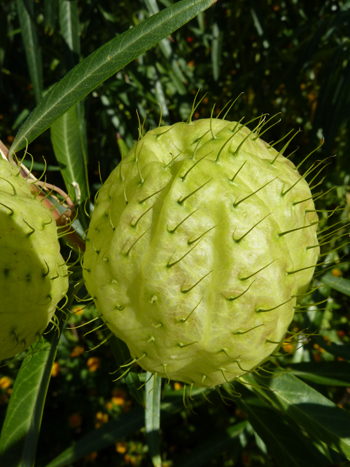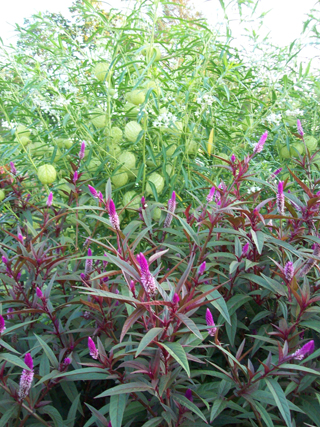Asclepias physocarpa
 As we celebrate the first official day of spring, garden magazines are teasing us with great annuals for our summer garden. The conversation starter Asclepias physocapa is featured as a plant pick in Fine Gardening’s April issue this spring. This delightful Asclepias is known by some colorful common names including the balloon plant, family jewels tree, and hairy balls. All of these are inspired by the decorative, unique seed pods it produces in late summer.
As we celebrate the first official day of spring, garden magazines are teasing us with great annuals for our summer garden. The conversation starter Asclepias physocapa is featured as a plant pick in Fine Gardening’s April issue this spring. This delightful Asclepias is known by some colorful common names including the balloon plant, family jewels tree, and hairy balls. All of these are inspired by the decorative, unique seed pods it produces in late summer.

Asclepias physocarpa seed pods photo credit: J. Coceano
Fuzzy inflated lime-green seed pods covered with soft spines adorn this six-foot tall plant. These pods are a result of clusters of small white flowers with purple centers. Typical of plants in the butterfly weed family, Asclepiadaceae, the balloon plant is a monarch magnet and a caterpillar beacon. The seed pods then mature into the characteristics whisps of seed heads for Asclepias.

Asclepias physocarpa grown with Celosia at Longwood Gardens. photo credit: J. Coceano
Asclepias physocarpa can be planted in rear of your perennial border, as it can reach four to six feet in width and six feet in height. This annual prefers full sun to partial shade. Experiment with the balloon plant this gardening season for a great conversation piece with your neighbors. It will be available at the Unusual Tropicals and Annuals Sale on May 21 and 22.





Lorraine Rallof
Posted at 22:49h, 15 AugustThis sounds like an interesting plant. I suppose it wouldn’t grow in the mid to northeastern part of Wisconsin?! Very pretty flowers & unique seed pods……..
Andrew Bunting
Posted at 07:44h, 16 AugustLorraine,
We grow this plant as a tender perennial for the summer. From seed it will grow 5-7′ tall and produce the inflated fruits. It will be fine in your garden in northeastern Wisconsin for the summer. Start plants indoors from seed and plant out after your last frost free date.
Andrew Bunting, Curator
Scott Arboretum
R. A. Hahn
Posted at 18:50h, 22 AugustWe potted this plant in small 18″ diameter tubs on either side of a set of stairs. We have had so many inquiries about it, I printed your info sheet and gave it to the entrance personell so they would be better informed to answer questions.
With a minimum amount of care the plant achieved about a 4′ by 4′ height and width and seed pods by the second week in August.
Colin
Posted at 21:15h, 07 AugustThese are great. I bookmarked the page. Can you tell me what type of Celosia that is, in that one picture?
Colin
Posted at 21:15h, 07 AugustPlease & Thank You.
Andrew Bunting
Posted at 08:20h, 08 AugustThat is Celosia ‘Flamingo Feather’
mary
Posted at 13:11h, 21 JulyIs there any way that this tree can be grown in Phoenix?
Andrew Bunting
Posted at 08:00h, 23 JulyWe grow both of these plants as annuals. At best, they might be perennials in Phoenix.
Stephanie Doe
Posted at 19:18h, 22 OctoberWhere can I purchase seeds of Asclepias physocarpa ?
Gail
Posted at 10:21h, 05 JuneI have one asclepias physocarpus plant. I read “somewhere” that a single plant cannot produce pods. Is this correct? If yes, then can I take a cutting from this one to produce a second plant so it can be cross pollinated? The closest place that sells this plant is a 4 hour drive one way. (I was lucky to purchase this plant at a garden show. But I was not informed that I had to have two before it would produce pods.)
Josh Coceano
Posted at 09:30h, 08 JuneHi Gail,
A single plant will produce pods. I can’t find any source that states you need multiple plants for cross pollination or seed pod production. You are correct though, it is not readily available in the market.
Josh Coceano
Horticulturist